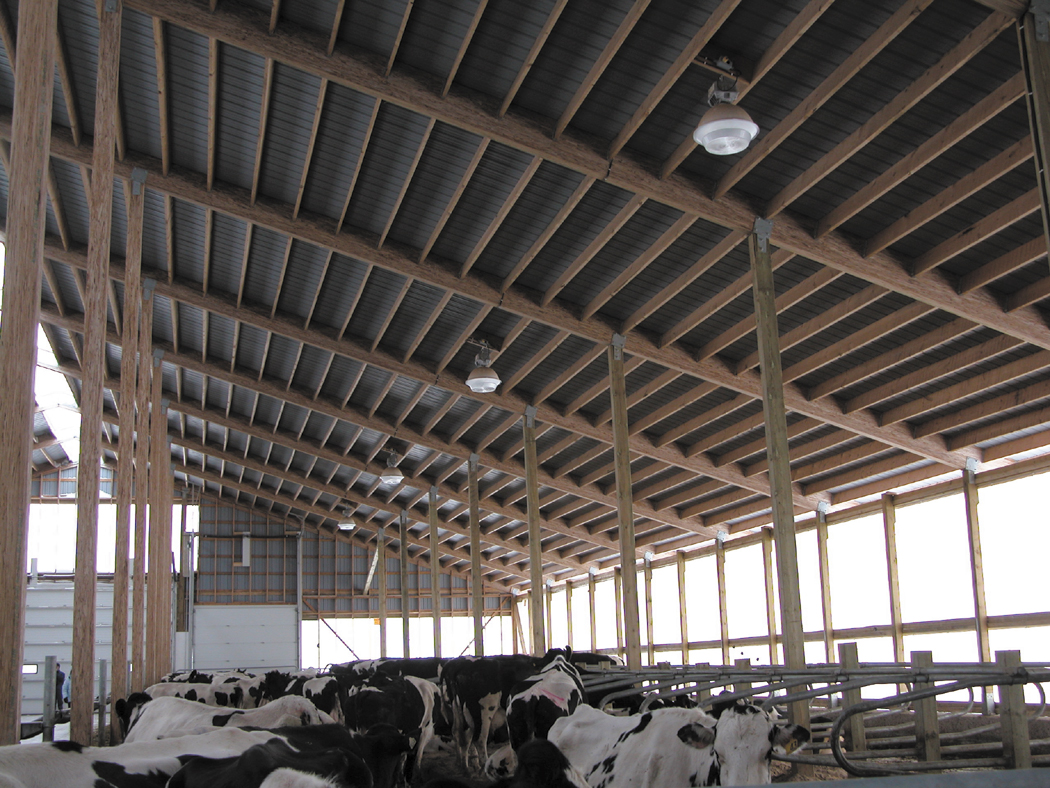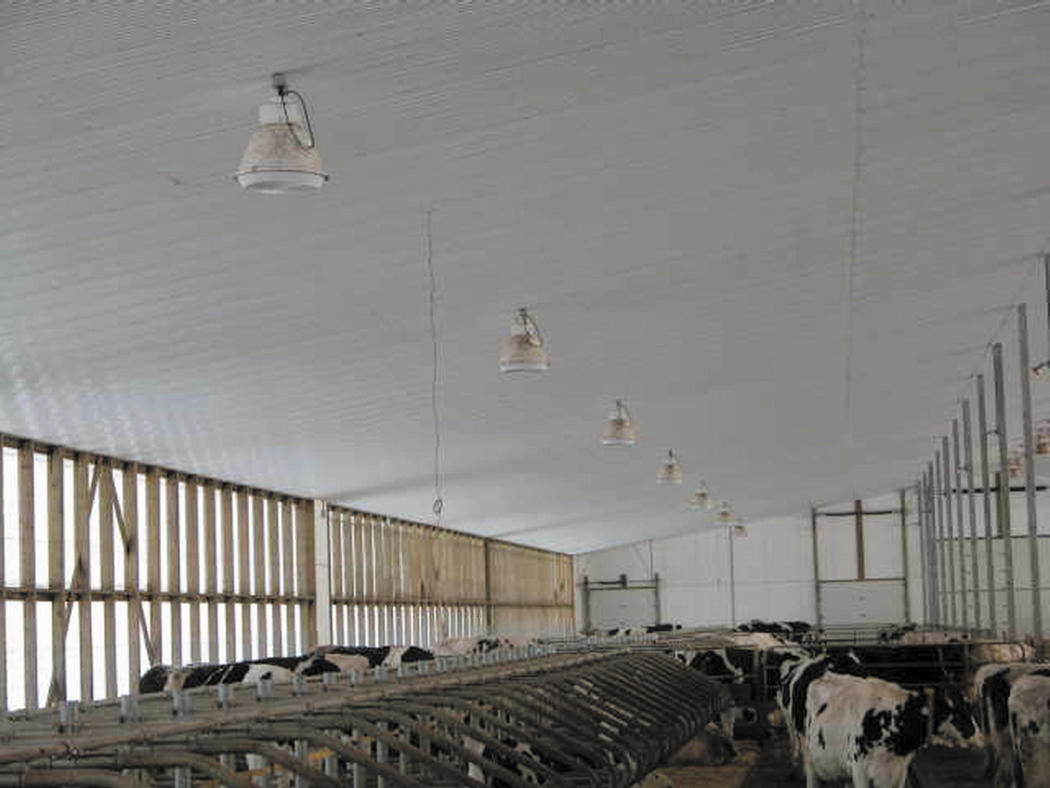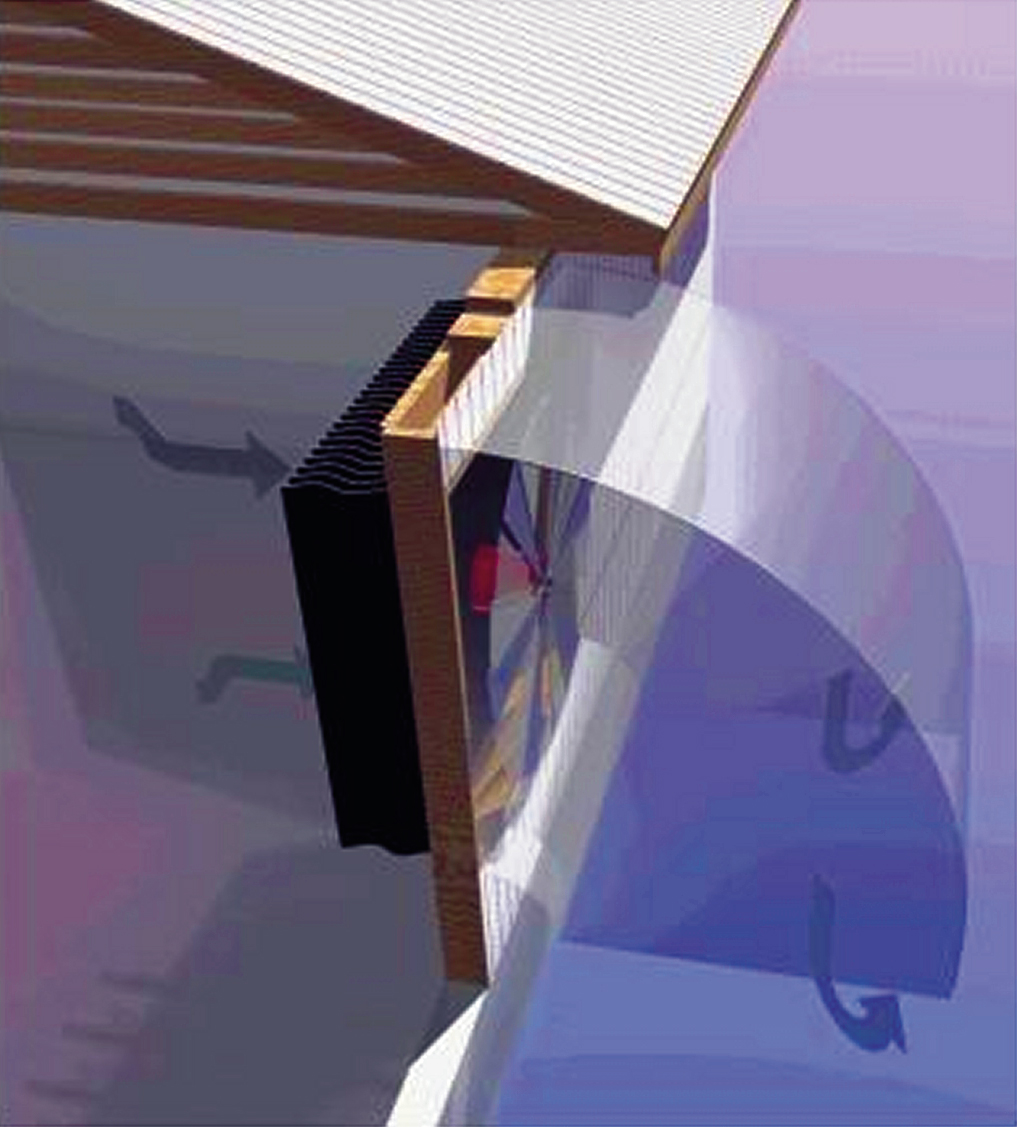
Source: OMAFRA
Introduction
This fact sheet discusses opportunities for increasing milk production by adjusting the lighting in dairy barns. It explains some of the practical challenges of controlling long-day and short-day photoperiods for milking and dry cows.
Long-day photoperiod for milking cows (LDPP)
A well-lit barn improves operator efficiency, comfort and safety (Figure 1). In addition, research has shown that milk production can be increased by regulating the dairy cow’s exposure to light. Milking cows exposed to 16–18 hours of light with a brightness of 162–215 lux (15–20 ft-candles) followed by 6–8 hours of darkness have consistently increased their milk yield by 8%–10%. This lighting pattern is often referred to as a long-day photoperiod (LDPP).

Why a long-day photoperiod increases milk production
Light hitting the eye of the cow activates certain hormones. The first response is to send a signal to suppress the release of the hormone melatonin. Cows use the daily pattern of melatonin to set their internal clock, influencing the secretion of a number of other hormones, including insulin-like growth factor-1 (IGF-1). Increases in IGF-1 influence the mammary gland to increase milk production. Increasing the hours of daylight decreases the amount of melatonin in the cow, which in turn increases the production of IGF-1, which increases milk production.
Other factors to consider
Milk yield responds to an increased photoperiod in about 2–4 weeks. The response is gradual, but consistent and repeatable. In general, studies show that increases in milk production can range from 5%–16% but are most consistently in the 8%–10% range.
Cows exposed to long days while lactating consume more feed than do cows exposed to a natural photoperiod. Cows eat more because they are producing more milk — they do not produce more milk because they are eating more. In summary, they produce more milk and then consume more feed to meet the increased demand for energy to make the milk.
Photoperiod does not affect the protein or solid content of milk. It causes a slight decrease in fat content, but the increase in milk yield more than compensates for the effect on fat and the cost of the increased feed intake.
However, there is no benefit to providing 24 hours of continuous light. Without a period of darkness, cows can’t determine the length of the day, which then causes them to lose their ability to respond to extra lighting. Experience shows that 6–8 hours of uninterrupted darkness each day are required for cows to detect and respond to the lengthened photoperiod.
A common misconception is that cows require a low level of illumination (night light) in order to find feed and water during darkness. This is not true, as cows can find their way around in the dark. However, some light may be necessary for management purposes. Dim red lights don’t appear to affect the cow’s perception of darkness. They are considered a good option for night light in dairy barns since they don’t suppress melatonin levels and affect physical, mental and behavioural rhythms in animals. Low‑intensity red lighting (7.5-W bulbs), mounted 6–9 m (20–30 ft) apart and 3 m (10 ft) above the floor, provides adequate lighting for observing cows without upsetting the photoperiod response.
Light levels should be uniform throughout the barn, or at least anywhere the cow can see light (Figure 2). Putting lights over the feed alley limits the exposure to and effectiveness of extra lighting.

Short-day photoperiod for dry cows
A short-day photoperiod (SDPP) is most appropriate for dry cows. Cows that are continually exposed to LDPPs will gradually lose their ability to increase milk production during the long days. Short days appear to “reset” the cow’s ability to respond to a long-day photoperiod in the next lactation. This means dry cows should not have the same lighting as lactating cows. Limiting light exposure of the dry cows to less than 12 hours each day allows their internal clock to reset, ensuring that during their next lactation, a long-day photoperiod can again affect milk yield.
Perhaps of greater interest to dry cow management are the apparent effects of an SDPP on udder health and disease resistance. Preliminary laboratory studies suggest that cows exposed to an SDPPwhen dry are more able to resist a new infection.
The response to an SDPP in the dry period is consistent with the effects of calving season on milk yield. Cows calving in late winter in the northern hemisphere produce more milk than do those that calve in the summer. Prolactin (PRL) secretion may also play a role in the observed effects. The effects of the environment on PRL secretion and sensitivity during the dry period dramatically influence subsequent milk yield. Physiologically, we would expect that during the winter, dry cows would experience the lowest concentrations of PRL because of short days and low temperatures. During the summer, dry cows would experience elevated PRL secretion because of high ambient temperatures and long days. This PRL effect is a likely factor in explaining the advantage of including an SDPP between LDPPs.
Photoperiod for prepubertal heifer
Studies have shown that LDPPs affect various aspects of dairy heifer growth. They lead to greater mammary growth and lower the age to puberty by an average of 1 month. Breeding and calving occurred earlier in heifers exposed to LDPPs compared to heifers in SDPPs. Feed intake did not differ between the two photoperiods, and heifers exposed to LDPPs produced more milk.
LDPP versus SDPP for milking and dry cows
A clear challenge emerges when considering the lighting needs for milking and dry cows — if milking cows need an LDPP and dry cows need an SDPP, they cannot both be housed in the same barn. Milking cows can continue to be housed in a well-lit, naturally ventilated barn with supplemental lighting, but dry cows will need a barn that can be darkened. Since light levels cannot be reduced in a naturally ventilated barn, dry cows will require separate housing with fan ventilation.
Modifications for SDPP
Poultry producers use a variety of light-blocking techniques for ventilation that can also be applied to dry cow housing. A number of commercial air-blocking devices are also available for fans and inlets (Figure 3). Designs using adjustable air inlets or tunnel ventilation can be used for dry cow housing. It may be most practical to house dry cows in existing two-storey barns if available. These barns may be already dark to start with and will require modifications to windows, air inlets and exhaust fans. The question becomes, “How practical is it to make a barn totally dark?”
Barns should be assessed individually.

Design requirement summary
To implement long and short photoperiod adjustments, follow these design requirements:
- Milking cows require light levels of 162–215 lux (15–20 ft-candles), 16–18 hours/day, followed by a dark period of 6–8 hours/day.
- Keep light levels as uniform as possible throughout the barn when measured at cow level.
- Dry cows should have a dark period of at least 12 hours/day.
- Prepubertal heifers exposed to LDPP have greater mammary development and reach puberty at a lower age.
For more information on energy efficiency and different lighting options in freestall barns, see the OMAFRA publication Lighting options for free-stall housing.
References
ASAE. “Lighting for Dairy Farms and the Poultry Industry.” ASAE Standards. 40th ed. EP344.2. St. Joseph, MI: ASAE, 1993.
Chastain, J.P., and R.S. Hiatt. “Supplemental Lighting for Improved Milk Production.” Electric Power Research Institute Bulletin. Columbia, MO: National Food and Energy Council, 1998.
Dahl, G.E., B.A. Buchanan and H.A. Tucker. “Photoperiodic Effects on Dairy Cattle: A Review.” Journal of Dairy Science 83 (2000): 885-93.
Ludington, D., and C.A. Gooch. “Lighting Design Considerations for Photoperiod Management in Freestall and Tiestall Dairy Barns.” In Building Freestall Barns and Milking Centers, 125-38. Camp Hill, PA: Natural Resource, Agriculture, and Engineering Service, 2003.
Miller, A.R.E., R.A. Erdman, L.W. Douglass and G.E. Dahl. “Effects of Photoperiodic Manipulation During the Dry Period of Dairy Cows.” Journal of Dairy Science 83 (2000): 962-7.
Nolan, D., D. Amaral-Phillips and J. Bewley. “The Effect of Lighting Manipulation on Dairy Cattle Management.” College of Agriculture, Food and Environment, University of Kentucky.
This fact sheet was updated by Rajan Niraula, P. Eng., dairy, beef and goat housing and equipment engineering specialist, OMAFRA.








